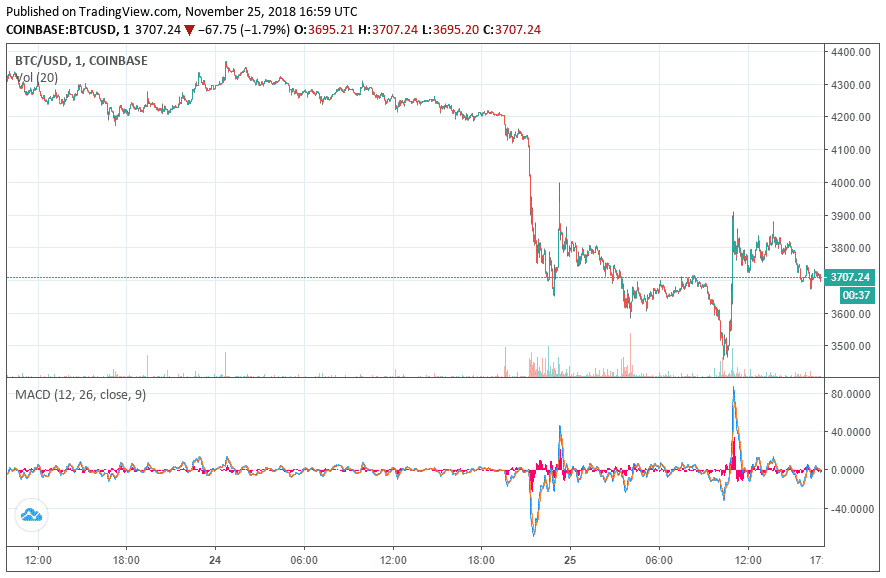Bitcoin Price Plunges to New Yearly Low at $3,456: What’s Causing it?

On Coinbase and other major fiat-to-cryptocurrency exchanges, the Bitcoin price (BTC) has dropped to a new yearly low at $3,456.
Over the past 24 hours, despite its relatively low daily volume at around $5.2 billion, BTC demonstrated a drop of over 12 percent, showing weakness in short-term momentum.
The volume of BTC has since risen to $6.3 billion, mostly due to an overwhelming amount of sell orders.
Free Fall

The drop in the price of the dominant cryptocurrency on November 25 remains a troubling sign for the short-term trend of the crypto market because the sell-off was materialized with low volume.
Without immense sell-pressure, BTC dropped to a new yearly low at $3,456. In contrast, when the price of BTC initially dropped to the low $5,000 region in early November, the volume of BTC averaged around $8 billion.
On November 23, when the Bitcoin price dropped to $4,100 for the first time in 2018, the volume of BTC was still relatively low at $5.1 billion. In the past week, Bitcoin has experienced one of its worst sell-offs in the year without the presence of large sell orders from bears.
A CCN.com report read:
“One alarming trend of both Bitcoin and other major cryptocurrencies is that the prices of leading digital assets are dropping by relatively large margins with low daily volumes. The volume of BTC is averaging at around $5.1 billion, which suggests that BTC has fallen by more than 3.5 percent in the past 24 hours without significant sell-pressure from bears.”
Peter Brandt, a prominent trader and technical analyst, stated that Bitcoin had entered a phase during which newcomers and casual retail traders capitulate while strong hands continue to accumulate more BTC.
“BTC is entering the stage of its life cycle when stale and weak money capitulates and strong hands accumulate strategically.”
As Coinbase CTO Balaji Srinivasan said at TechCrunch: Sessions held in Zug, Switzerland, the cryptocurrency market tends to go through a bubble-burst-build-rally cycle, and major investors in the sector believe the latest crash of BTC is no different.
One of the major factors subsequent to the in-fighting between Bitcoin Cash and Bitcoin Cash SV that has affected the cryptocurrency market is the abrupt decline of the US stock market and its impact on the global economy.
Due to the sell-off of investors in US markets, the stock markets of China, South Korea, Japan, and other leading economies in Asia have started to suffer as a consequence.
No Inverse Correlation Yet
Cryptocurrency is still an asset class in its infancy with relatively low liquidity and volume. For BTC to operate as an inversely correlated hedge against the global financial market, it would have to achieve multi-trillion dollar market valuation.
Until then, major cryptocurrencies are expected to be vulnerable to instability in the global economy especially during periods of uncertainty and doubt wherein the world’s largest asset managers and banks experience net outflows.
Featured Image from Shutterstock. Charts from TradingView .